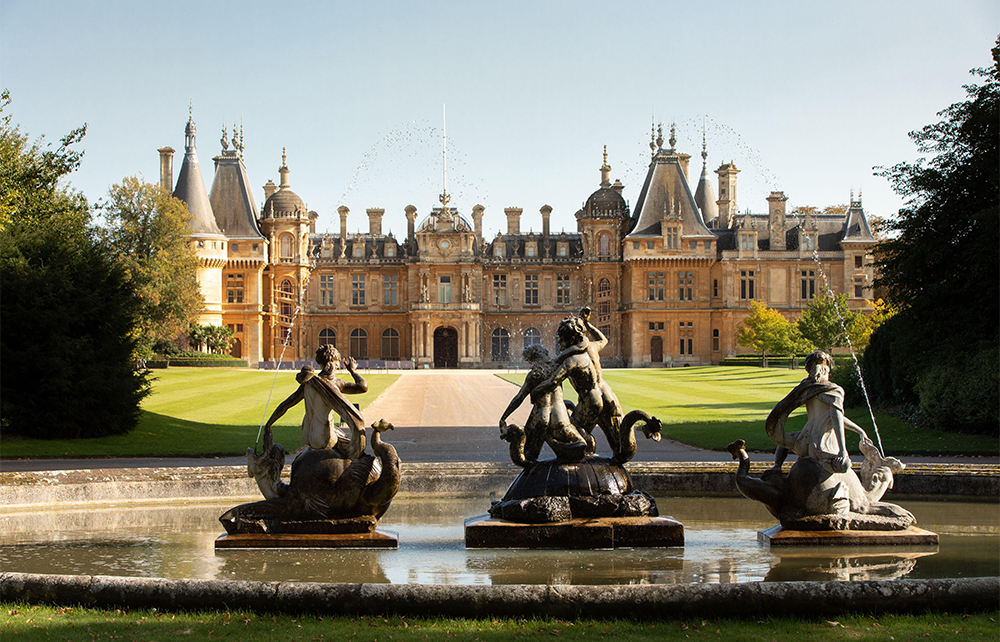The words ‘country houses’ immediately make one think of England, yet only five of the 15 featured in this hefty, impressively illustrated book are in Britain. It is a compilation of essays: part histories of various Jewish families, part architectural descriptions and part stories of the chateaux, mansions, villas and, of course, country houses all over Europe, owned and sometimes built by these families. Each chapter is by a different author.
The swimming pool was surrounded by such a profusion of lilies that the scent at night was overpowering
These homes had different functions. Some, like that of the German-born painter Max Liebermann, were built as traditional country retreats – his palatial town house was next to Berlin’s Brandenburg Gate. Others were inherited: the beautiful Frances Braham, daughter of a distinguished tenor, acquired Horace Walpole’s gothic masterpiece Strawberry Hill through the second of her four husbands. She first married the illegitimate son of the sixth Earl Waldegrave; then, widowed within a year, she married his younger (legitimate) brother, on whose death she inherited the Waldegrave estate, which included Strawberry Hill. She restored the house, filling it with treasures bought on forays to Europe with her third husband.
The property portfolio of the German Jewish family Cahen d’Anvers, several of whom married ‘out’, included a marvellous turreted Italian castle near Orvieto, presided over by the Anglo-Greek wife of Édouard Cahen d’Anvers, a pre-Raphaelite beauty painted by Whistler. Another was the château de Champs-sur-Marne, built in 1703. Here Édouard’s younger brother Louis entertained European royalty and intelligentsia at summer parties.
Other owners used their country houses not only as symbols of wealth and status (Hughenden, with Disraeli’s coat of arms emblazoned above the front door, and the letter ‘D’ liberally scattered throughout its rooms, springs to mind), but almost as museums – fitting backgrounds for their amazing collections of art and objets.
Perhaps the chief English example is Waddesdon Manor in Buckinghamshire, built in the early 1870s by the great collector Baron Ferdinand de Rothschild on the top of a hill – he was determined to outdo the nearby houses of other Rothschilds even in height above sea level. All the family were great collectors, sometimes buying en bloc to get better prices. Behind Waddesdon’s ornate exterior were rooms filled with exquisite furniture and paintings and, writes Juliet Carey, ‘treasure-cabinet wonders’ such as the Lyte Jewel belonging to James I and the Holy Thorn Reliquary of 1400, now in the British Museum.
After the Jewish Emancipation Act of 1858 these country houses were also symbols of integration. None was more illustrative of this than Nymans, the West Sussex estate bought by the German banker Ludwig Messel and inherited by his son and daughter-in-law Leonard and Maud, grandparents of Lord Snowdon (at whose 14th-century weekend retreat Old House, in Nymans’ grounds, Princess Margaret and her detective saw a ghost). ‘Within a single generation,’ writes John Hilary, ‘Nymans came to symbolise the quintessential Englishness of the Messel family.’
Trent Park, in Enfield, became a playground for the rich. Its lease was bought in 1908 by Sir Edward Sassoon, MP for Hythe, whose Baghdad Jewish family had made a fortune from opium, and was inherited by his only son Philip, a politician and society figure of whom many stories were told, mostly emphasising his flamboyance, not to say eccentricity. Some of the garden statues were given gilded highlights; on the lake, instead of ducks and swans, were flamingos, a scarlet ibis and flocks of penguins that Sir Philip fed himself. The grounds were extensively re-landscaped and a heated outdoor swimming pool, the first in Europe, was installed. This blue bathing pool, wrote the politician Robert Boothby, was surrounded by such a profusion of lilies that the scent at night was overpowering.
The luxury of weekend parties there became legendary. Before each one a procession of carts stacked with roses and azaleas would leave Covent Garden to fill every available corner of the house with flowers. Here could be found (Boothby again) ‘Winston Churchill arguing over the teacups with Bernard Shaw, Lord Balfour dozing in an armchair and Rex Whistler absorbed in his painting’. A male guest would find a cocktail and a red carnation for his buttonhole on the dressing table, before a delicious dinner served by white-coated footmen. After dinner, wrote Boothby, came ‘a firework display over the lake… with songs from Richard Tauber, which we listened to on the terraces by moonlight’.
The house was requistioned in the second world war and served as an interrogation centre for captured high-ranking German officers. It was here that secret listeners in the sealed-off basement overheard vital conversations going on in the Sassoons’ elegant former drawing room. Lulled by their gentlemanly treatment – wine at dinner, daily newspapers, radio access – and believing the war virtually lost, the generals talked unguardedly about the rocket technology being developed by Germany. This immediately prompted RAF reconnaissance, which confirmed the V-weapons being programmed at Peenemünde. These conversations also revealed to the appalled listeners, many of them German-Jewish refugees, much about the Nazi death camps (all the major concentration camps are mentioned in the transcripts) and the mass killings of Russians and Poles. ‘What will they say when they discover the graves in Poland?’ wondered one of the captives. The answer, of course, came at Nuremberg.







Comments